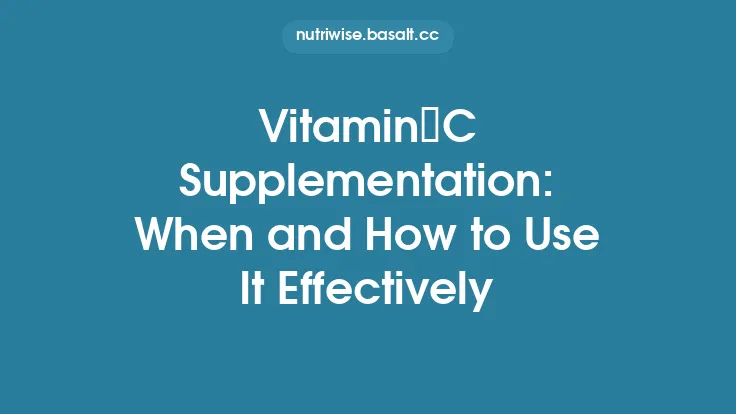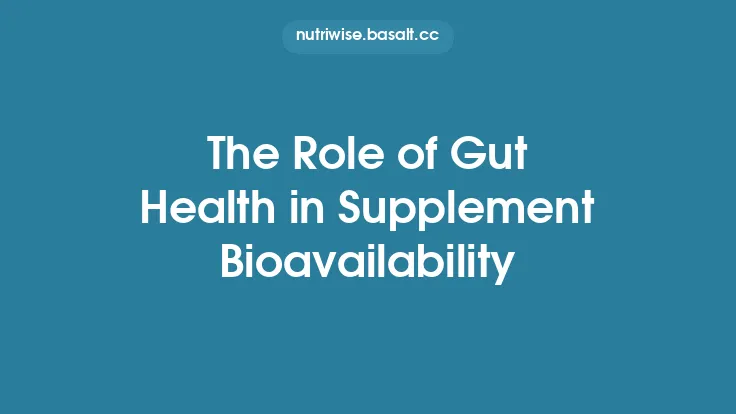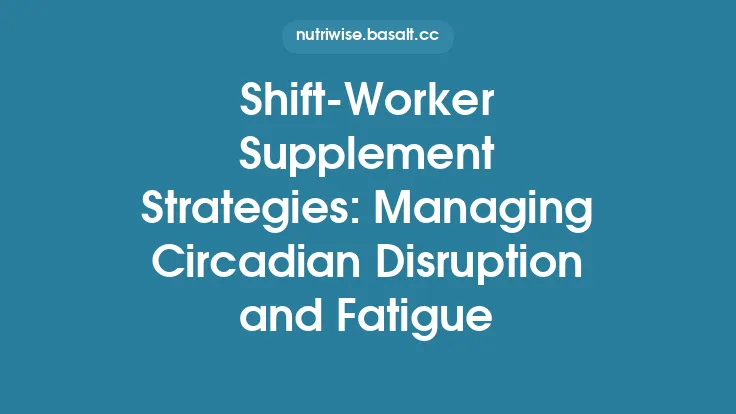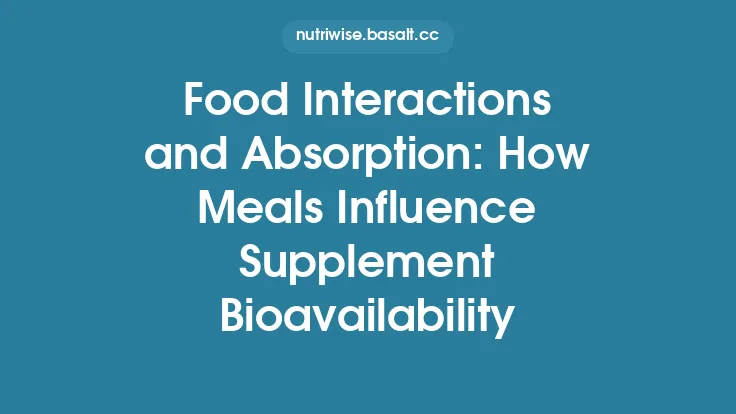The effectiveness of any dietary supplement hinges on more than just the ingredient list; it depends on how much of the active compound actually reaches systemic circulation in a usable form. This concept—bioavailability—encompasses the fraction of a nutrient that survives the journey from ingestion to the bloodstream, remains chemically intact, and is capable of exerting its intended physiological effect. While the raw potency of a supplement is important, the delivery system, molecular architecture, and stability of the product often dictate the real-world outcomes users experience. Below, we explore the most reliable, evergreen strategies for maximizing bioavailability, focusing on formulation science, delivery technologies, molecular tweaks, and practical quality‑control measures that can be applied across a wide range of nutrients and botanicals.
Understanding Bioavailability: Core Concepts
- Absorption vs. Utilization
- Absorption refers to the passage of a compound across the intestinal epithelium into the portal circulation.
- Utilization (or bioefficacy) describes the subsequent distribution, metabolism, and interaction with target tissues. A supplement may be well‑absorbed but rapidly metabolized into inactive forms, reducing its functional impact.
- First‑Pass Metabolism
- The liver’s enzymatic machinery (e.g., cytochrome P450 isoforms) can substantially diminish the concentration of certain compounds before they reach systemic circulation. Formulations that bypass or mitigate first‑pass metabolism (e.g., sublingual, buccal, or transdermal routes) can preserve a larger proportion of the active ingredient.
- Physicochemical Barriers
- Molecular size, polarity, and solubility dictate a compound’s ability to cross cellular membranes. Lipophilic molecules traverse lipid bilayers more readily, whereas hydrophilic substances often require carrier-mediated transport.
- Stability Within the Gastrointestinal Tract
- The acidic environment of the stomach (pH ≈ 1–3) and the alkaline milieu of the small intestine (pH ≈ 6–8) can degrade pH‑sensitive nutrients (e.g., certain vitamins, polyphenols). Protective coatings or encapsulation can shield labile compounds until they reach a more favorable absorption site.
Formulation Strategies that Boost Absorption
| Strategy | Mechanism | Typical Applications |
|---|---|---|
| Micronization | Reduces particle size to the sub‑micron range, increasing surface area and dissolution rate. | Minerals (e.g., zinc, magnesium), poorly soluble plant extracts. |
| Chelation | Binds the mineral to an organic ligand (e.g., amino acid) to form a neutral complex that is more readily absorbed via amino acid transporters. | Calcium (as calcium citrate-malate), iron (as ferrous bisglycinate). |
| Salt Forms | Selecting a more soluble salt (e.g., magnesium glycinate vs. magnesium oxide) enhances dissolution in intestinal fluids. | Magnesium, potassium, calcium. |
| Co‑Crystallization | Integrates two or more active ingredients into a single crystal lattice, improving solubility and stability. | Vitamin C with calcium, curcumin with piperine. |
| Enteric Coating (non‑food‑interaction focus) | Delays release until the formulation reaches the higher pH of the small intestine, protecting acid‑labile compounds. | Probiotics, certain enzymes, vitamin B12. |
| Lipid‑Based Vehicles | Incorporates the active into oils, phospholipids, or triglycerides, facilitating micelle formation and lymphatic transport. | Fat‑soluble vitamins (A, D, E, K), coenzyme Q10, curcumin. |
Advanced Delivery Technologies
- Liposomal Encapsulation
- Liposomes are phospholipid vesicles that encapsulate hydrophilic or lipophilic actives, mimicking cell membranes. This structure protects the payload from degradation and promotes fusion with intestinal epithelial cells, enabling direct cytoplasmic delivery. Clinical studies have demonstrated markedly higher plasma concentrations of vitamins C and B12 when delivered via liposomes versus conventional tablets.
- Nanoparticle Systems
- Polymeric nanoparticles (e.g., PLGA—poly(lactic‑co‑glycolic acid)) can be engineered to release their cargo in a controlled manner, protect sensitive compounds from oxidative stress, and even target specific tissues through surface functionalization. Curcumin nano‑formulations, for instance, have shown up to a tenfold increase in bioavailability compared with standard powders.
- Solid Lipid Nanoparticles (SLNs) and Nanostructured Lipid Carriers (NLCs)
- These lipid‑based carriers combine the stability of solid lipids with the loading capacity of liquid lipids, offering a versatile platform for both water‑soluble and fat‑soluble nutrients. They improve intestinal permeability and can be designed for sustained release.
- Sublingual and Buccal Tablets
- By placing the supplement under the tongue or against the cheek, the active bypasses the gastrointestinal tract and first‑pass metabolism, entering the bloodstream directly through the rich capillary network. This route is especially advantageous for compounds with poor oral stability, such as certain peptides and hormones.
- Transdermal Patches
- For nutrients that can permeate the skin (e.g., nicotine, certain vitamins, and hormones), transdermal delivery provides a steady, controlled release over several hours. Modern adhesive technologies and permeation enhancers (e.g., oleic acid) have expanded the range of viable transdermal nutrients.
Molecular Modifications to Improve Uptake
| Modification | Rationale | Example |
|---|---|---|
| Esterification | Converting a polar molecule into a more lipophilic ester can enhance membrane permeability; the ester is later hydrolyzed by esterases to release the active form. | Vitamin D3 (cholecalciferol) is naturally an ester; synthetic esterified forms of omega‑3 fatty acids improve absorption. |
| Pro‑Drug Design | Attaches a carrier moiety that is cleaved enzymatically after absorption, delivering the active compound in a more bioavailable form. | L‑carnitine pro‑drugs that improve cellular uptake for mitochondrial support. |
| Glycosylation | Adding a sugar moiety can increase solubility and exploit glucose transporters for intestinal uptake. | Quercetin‑3‑glucoside shows higher plasma levels than aglycone quercetin. |
| Cyclodextrin Complexation | Cyclodextrins are cyclic oligosaccharides that form inclusion complexes with hydrophobic molecules, enhancing aqueous solubility and protecting against degradation. | Curcumin‑β‑cyclodextrin complexes dramatically increase water solubility. |
Synergistic Co‑Factors and Enzyme Support (Beyond Meal Context)
While the timing of intake relative to meals is outside the scope of this discussion, the presence of specific co‑factors can still be leveraged to improve the metabolic conversion and transport of nutrients:
- Piperine (Black Pepper Alkaloid) – Inhibits certain hepatic and intestinal glucuronidation enzymes, slowing the metabolism of compounds like curcumin and resveratrol, thereby extending their plasma half‑life.
- Vitamin C as a Reducing Agent – Stabilizes iron in the ferrous (Fe²⁺) state, facilitating its uptake via the divalent metal transporter (DMT1). Formulations that pair iron with ascorbic acid can achieve higher absorption without relying on dietary sources.
- Manganese and Magnesium as Cofactors for Enzymatic Activation – Certain enzymes (e.g., superoxide dismutase) require these minerals for optimal activity; co‑formulating them with antioxidant nutrients can enhance the functional impact of the antioxidant itself.
Optimizing Storage and Handling for Potency Preservation
Even the most sophisticated delivery system can lose efficacy if the product degrades before consumption. Key considerations include:
- Temperature Control
- Heat accelerates oxidative reactions and hydrolysis. Store sensitive supplements (e.g., omega‑3 oils, CoQ10) in a cool, dark environment, ideally below 25 °C (77 °F). Refrigeration can extend shelf life for liquid emulsions.
- Light Protection
- UV radiation can degrade photosensitive compounds such as riboflavin, vitamin A, and certain phytochemicals. Amber‑colored or opaque containers, along with foil linings, mitigate photolysis.
- Oxygen Exclusion
- Oxidative rancidity is a primary cause of potency loss in polyunsaturated fatty acids and some antioxidants. Nitrogen flushing, vacuum sealing, or inclusion of oxygen‑absorbing packets can preserve product integrity.
- Moisture Barriers
- Hygroscopic ingredients (e.g., certain vitamins, minerals) can clump or hydrolyze when exposed to humidity. Desiccants within packaging and moisture‑resistant blister packs help maintain dry conditions.
- Shelf‑Life Validation
- Manufacturers should conduct accelerated stability testing (e.g., 40 °C/75 % RH for six months) to predict real‑world expiration dates. Look for products that provide a “best‑by” date rather than a vague “use within X months after opening” statement.
Assessing Bioavailability: Tools and Metrics
To verify that a supplement truly delivers its promised bioavailability, several analytical and clinical approaches are employed:
- Pharmacokinetic (PK) Studies
Measure plasma concentration over time (Cmax, Tmax, AUC) after a single dose. Comparative PK profiles between standard and enhanced formulations directly illustrate absorption improvements.
- Biomarker Response
For nutrients with well‑characterized functional markers (e.g., serum 25‑hydroxyvitamin D for vitamin D, ferritin for iron), changes in these biomarkers after supplementation provide indirect evidence of bioavailability.
- In Vitro Dissolution Testing
Simulated gastric and intestinal fluids assess how quickly a formulation releases its active ingredient. Faster, complete dissolution generally correlates with higher in vivo absorption.
- Caco‑2 Cell Permeability Assays
Human intestinal epithelial cell monolayers model the intestinal barrier, allowing researchers to estimate transcellular transport rates of various formulations.
- Isotopic Tracer Techniques
Stable isotopes (e.g., ¹³C‑labeled nutrients) enable precise tracking of absorption and metabolic fate without the confounding influence of endogenous pools.
Choosing High‑Quality Products
When selecting a supplement with optimized bioavailability, consider the following criteria:
- Transparent Ingredient Disclosure
- Full specification of the active form (e.g., “magnesium glycinate” vs. “magnesium oxide”) and any delivery technologies used.
- Third‑Party Verification
- Certifications from organizations such as NSF International, USP, or Informed‑Sport confirm that the product meets purity and potency standards.
- Stability Data
- Look for manufacturers that provide stability testing results, including storage conditions and expiration timelines.
- Clinical Evidence
- Preference for products backed by peer‑reviewed studies demonstrating enhanced bioavailability relative to conventional forms.
- Manufacturing Practices
- GMP‑certified facilities ensure consistent production quality and reduce the risk of contamination.
Practical Checklist for Maximizing Supplement Effectiveness
- Identify the most bioavailable form of the nutrient you need (e.g., methylcobalamin for B12, lutein ester for eye health).
- Prefer formulations that incorporate proven delivery technologies (liposomal, nanoparticle, enteric coating) when the nutrient is known to have low native absorption.
- Check for stabilizing co‑factors that protect the active compound from metabolic breakdown (e.g., piperine for curcumin).
- Verify packaging integrity—amber bottles, nitrogen flushing, and desiccants are signs of thoughtful product design.
- Review third‑party testing reports to confirm that the label accurately reflects the content and that contaminants are below acceptable limits.
- Consider the route of administration—sublingual, buccal, or transdermal options may be superior for certain nutrients, especially those prone to first‑pass metabolism.
- Monitor biomarkers (if applicable) after a reasonable trial period to ensure the supplement is delivering the expected physiological benefit.
By focusing on these scientifically grounded strategies—optimizing molecular form, leveraging cutting‑edge delivery platforms, safeguarding stability, and rigorously evaluating efficacy—you can substantially increase the proportion of a supplement that reaches its target site in an active state. This, in turn, translates into more reliable health outcomes, better value for the consumer, and a clearer path toward achieving the intended nutritional goals.





